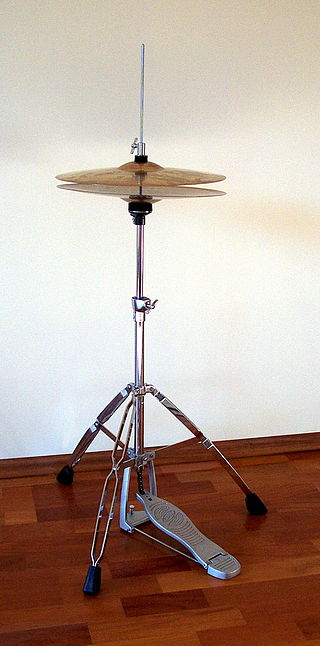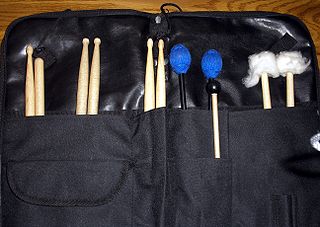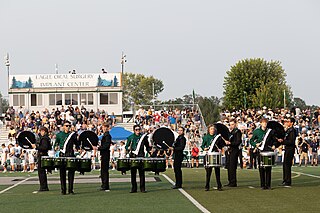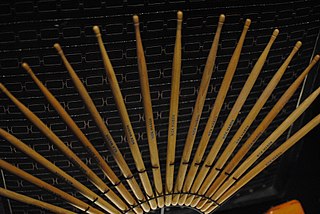
A drum kit is a collection of drums, cymbals, and sometimes other auxiliary percussion instruments set up to be played by one person. The drummer typically holds a pair of matching drumsticks or special wire or nylon brushes; and uses their feet to operate hi-hat and bass drum pedals.

A hi-hat is a combination of two cymbals and a pedal, all mounted on a metal stand. It is a part of the standard drum kit used by drummers in many styles of music including rock, pop, jazz, and blues. Hi-hats consist of a matching pair of small to medium-sized cymbals mounted on a stand, with the two cymbals facing each other. The bottom cymbal is fixed and the top is mounted on a rod which moves the top cymbal toward the bottom one when the pedal is depressed.

A percussion instrument is a musical instrument that is sounded by being struck or scraped by a beater including attached or enclosed beaters or rattles struck, scraped or rubbed by hand or struck against another similar instrument. Excluding zoomusicological instruments and the human voice, the percussion family is believed to include the oldest musical instruments. In spite of being a very common term to designate instruments, and to relate them to their players, the percussionists, percussion is not a systematic classificatory category of instruments, as described by the scientific field of organology. It is shown below that percussion instruments may belong to the organological classes of idiophone, membranophone, aerophone and chordophone.
A crash cymbal is a type of cymbal that produces a loud, sharp "crash" and is used mainly for occasional accents, as opposed to a ride cymbal. It can be mounted on a stand and played with a drum stick, or by hand in pairs. One or two crash cymbals are a standard part of a drum kit. Suspended crash cymbals are also used in bands and orchestras, either played with a drumstick or rolled with a pair of mallets to produce a slower, swelling crash. Sometimes a drummer may hit two different crash cymbals in a kit at the same time to produce a very loud accent, usually in rock music.
The ride cymbal is a cymbal of material sustain used to maintain a beat in music. A standard in most drum kits, the ride's function is to maintain a steady pattern, sometimes called a ride pattern, rather than provide the accent of a crash cymbal. It is normally placed on the extreme right of a drum set, above the floor tom. It is often described as delivering a "shimmering" sound when struck soundly with a drumstick, and a clear ping when struck atop its bell.

A sizzle cymbal is a cymbal to which rivets, chains or other rattles have been added to modify the sound, attached either by means of holes bored in the cymbal or by means of an attachment known as a sizzler.

A percussion mallet or beater is an object used to strike or beat a percussion instrument to produce its sound.

Clash cymbals are cymbals played in matched pairs by holding one cymbal in each hand and striking the two together.

In western music, a China cymbal is a distinct type of crash cymbal designed to produce a bright, crisp, and explosive tone that has brought it the nickname trash cymbal. The name "China cymbal" comes from its shape, which is similar to that of the Chinese Bo. Such cymbals are most frequently mounted upside down on cymbal stands, allowing for them to be more easily struck and for a better sound.

Zills or zils, also called finger cymbals, are small metallic cymbals used in belly dancing and similar performances. They are called sāgāt in Egypt. They are similar to Tibetan tingsha bells. In Western music, several pairs can be set in a frame to make a tambourine.

A suspended cymbal is any single cymbal played with a stick or beater rather than struck against another cymbal. Common abbreviations used are "sus. cym.," or "sus. cymb.".

Marching percussion instruments are percussion instruments specially designed to be played while moving. This is achieved by attaching the drum(s) to a special harness worn by the drummer, although not all marching bands use such harnesses and instead use traditional baldrics to sling their drums.

Paiste is a Swiss musical instrument manufacturing company. It is the world's third largest manufacturer of cymbals, gongs, and metal percussion. Paiste is a Finnish and Estonian word that means "shine".

Electronic drums are a modern electronic musical instrument, primarily designed to serve as an alternative to an acoustic drum kit. Electronic drums consist of an electronic sound module which produces the synthesized or sampled percussion sounds and a set of pads, usually constructed in a shape to resemble drums and cymbals, which are equipped with electronic sensors to send an electronic signal to the sound module which outputs a sound. Like acoustic drums, the pads are struck by drum sticks and they are played in a similar manner to an acoustic drum kit, albeit with some differences in the drumming experience.
Orchestral percussion refers to the various percussion instruments used in an orchestral setting. It may also refer to the act of playing such instruments in an orchestral style. Many music schools and conservatories offer training for musicians interested in developing their skills as orchestral percussionists. Typically, an orchestral percussionist does not specialize in one particular instrument. Although there is no exhaustive list of all instruments that an orchestral percussionist must be able to play, there are particular instruments that are frequently used in the orchestral repertoire. This includes timpani, snare drum, bass drum, xylophone, glockenspiel, triangle, and tambourine.

A drum stick is a type of percussion mallet used particularly for playing snare drum, drum kit, and some other percussion instruments, and particularly for playing unpitched percussion.

A crash/ride cymbal is a medium weight, slightly tapered cymbal, normally in the 18–22-inch (460–560 mm) range, designed to serve in a drum kit as both a crash and a ride cymbal.
Heavy metal drumming is a style of rock music drum kit playing that developed in the late 1960s and early 1970s, largely in the United States and the United Kingdom. With roots in blues rock and psychedelic/acid rock drum playing, heavy metal drummers play with emphatic beats, and overall loudness using an aggressive performing style. Heavy metal drumming is traditionally characterized by emphatic rhythms and dense bass guitar-and-drum sound.

Zang means bell in Persian, for both large bells and small. The term has historically been applied to a number of ringing metal musical instruments, including large bells with clappers worn by elephants, smaller 3-9 inch bells worn on camels, horses, donkeys and cattle, 2-3 inch sheep bells, and tiny bells tied to the legs of hawks. It also applies to clusters of small bells worn by musicians and dancers, sewn onto cloth bracelets and anklets, or laced on a long string to be wrapped around the waist or hung as a necklace.



















